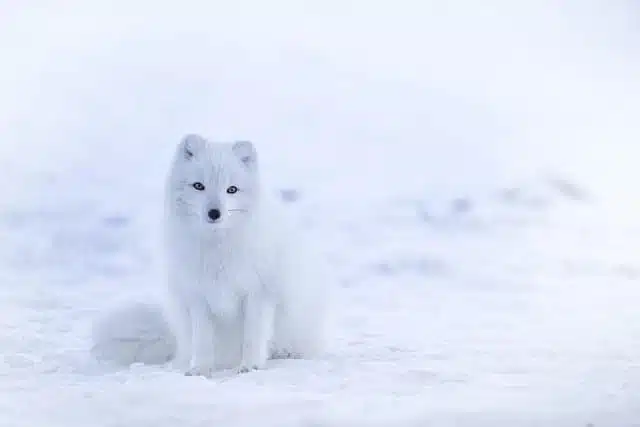Welcome to this article about 10 white animals.
Nature is typical for its diversity and distinctiveness in shape, form, and color. In the animal kingdom, colors are a big deal, and they sometimes indicate an animal’s sex, mating availability, individuality, or toxicity.
Of course, animal colors can also serve as protection to hide from predators or camouflage to ambush unsuspecting prey. At times, however, it may seem like Mother Earth has run out of colors in her palette, and she decides to keep some creatures plain and simple and make them white animals.
Difference Between Albino, Leucistic, And White Animals
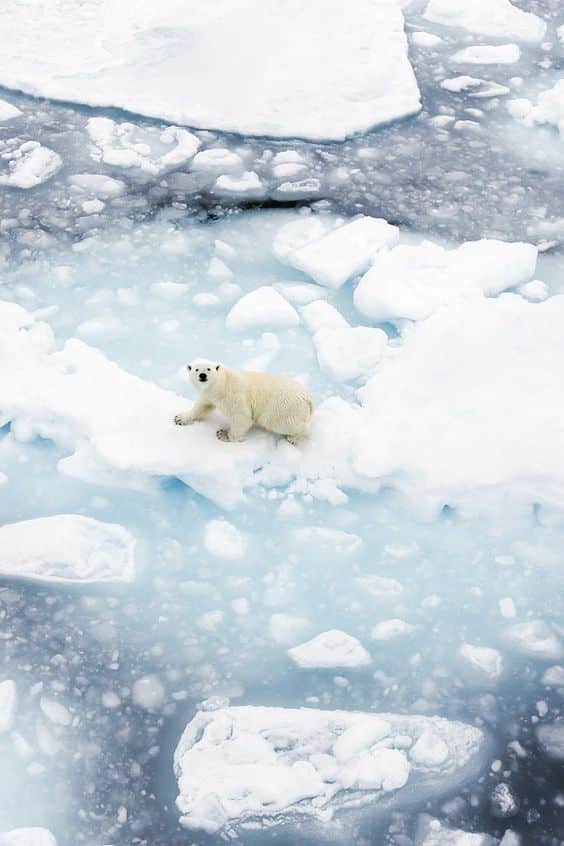
It is important that we don’t confuse white animals with albino or leucistic animals who have no pigmentation or partial pigmentation in their skin, fur, or plumage. Even though these animals appear white to the eyes, their “whiteness” comes about due to mutated genes affecting their melanocytes.
Melanocytes are cells responsible for the production of melanin pigment -the main pigment responsible for most animals’ skin, eye, and fur colors. These specialized cells are present but do not function properly in albino animals. Hence, animals with albinism are without color on their coats, and their eyes appear pale pink due to lack of pigmentation.
Leucistic animals suffer from leucism, a condition similar but different to albinism. Animals with this condition may have white surfaces or colored surfaces with white splotches. But what basically differentiates them from albino animals is that leucistic animals retain pigment in their eyes.
In contrast, white animals are not a genetic offshoot of mutated genes. We’ll be considering animals whose white color is a general physical characteristic across the species and not just a rare occurrence among species.
For instance, an albino alligator may be born white, but this is a seldom occurrence. On the other hand, polar bears are well represented as white across the species and throughout the seasons, while wild birds like ptarmigans change their colored plumage to white during winter.
White Animals
Now that we are clear about the distinctions let’s look at the ten of these cute white animals. Some of these animals have pronounced white integuments only among certain sexes of the species. Some change their colors in adaptation to seasonal changes. At the same time, others retain their colors across all seasons and demographics.
They are cute because white is associated with innocence, peacefulness, and purity, and this can certainly be said about many of these animals, bar a select few.
Even the few exceptions tend to stay away from environments where they will be easily provoked. But they are undeniably endearing and captivating to watch in their natural habitats.
10. Sheep
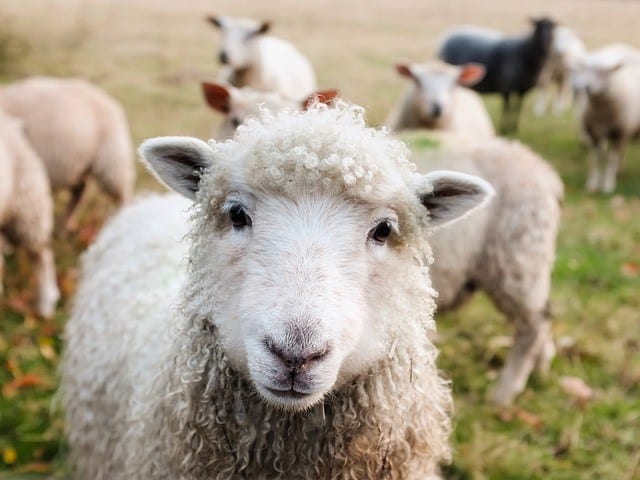
A familiar animal to start off our list, sheep, are widely distributed worldwide. These ruminant animals are typically reared commercially for their meat [lamb or mutton] and wool. Sheep wool, especially, is of great economic importance to humans, and its characteristic white color makes it sought-after because it is easier to transform.
It can sometimes be a sorry sight to see when these animals are sheared for their natural fur. They become prone to cold stress and may experience shock without their coats for temperature regulation. Sheep are of different breeds and can be of different colors, ranging from black and brown to grey, though most domesticated sheep are white animals because their wool has more dyeing options. Hence it is more economically viable.
Perhaps you’ve heard of the phrase “meek as a lamb .”This is not just an idiom or form of expression. Sheep are pretty docile and compliant animals, and this is one of the reasons why they were so easily domesticated centuries ago.
A common misconception is that sheep are unintelligent animals. On the contrary, sheep have been shown to have intelligence similar to that of cattle, and they can recognize their names, human faces, and different emotional states through facial characteristics.
Furthermore, their docile and compliant nature makes them cute and loveable companion animals when kept as pets.
9. Swans
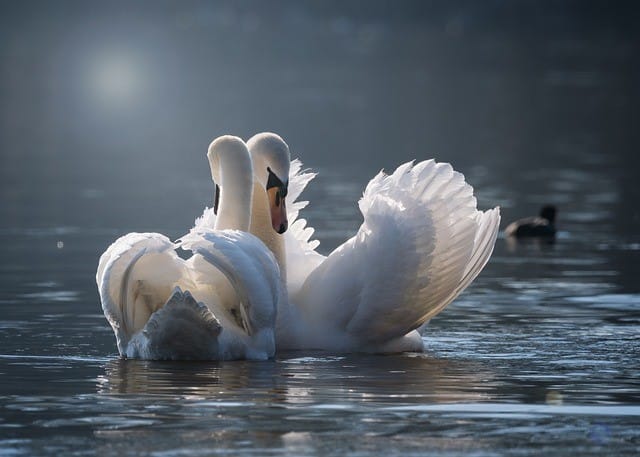
Swans are very close relatives to ducks and geese, and at an average length and wingspan of 1.5m and 3.1m, respectively, they are one of the largest water birds in the world. For a long time, there was a long-held belief that swans are all white and black swans do not exist. But this belief has been proven false since the discovery of black swan species in Australia.
Notwithstanding, swans are generally associated with their white plumage, and you’re more likely to come across a white swan than a black one. These majestic white animals are monogamous, forming lifetime pair bonds as early as 20 months old, even before reaching sexual maturity at four years.
In tandem, these bonds are rarely broken except for mating difficulty reasons. Also, male members of the species participate in nesting and hatching young chicks by incubation. The genus is mainly herbivores, feeding on aquatic plants and algae, but may sometimes supplement their diet with small marine animals.
Although swans are usually amiable creatures, spending their days on water and bonding with their mates and flock can be very aggressive if they sense a threat. Moreover, swans are very intelligent birds with strong memory similar to that of elephants. They can recall a human face that has been nice to them and often greet them in their head-bobbing fashion when this happens. They also don’t forget an unkind face, so keep that in mind.
In many cultures, these birds symbolize fidelity and purity because they tend to stay loyal to the same mates for life.
8. Mountain Goats
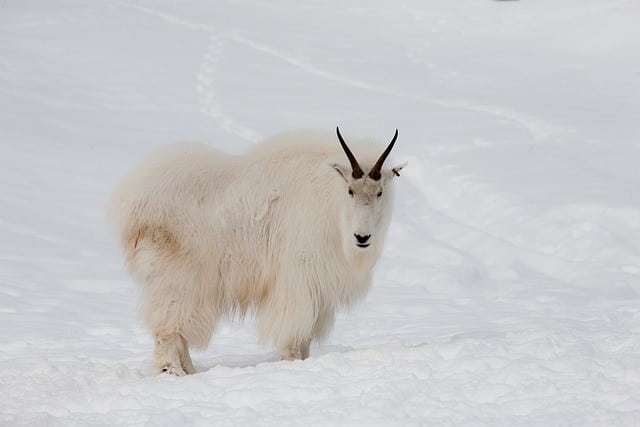
Native to mountainous regions of western North America (The Rocky Mountains and Cascade Mountain Ranges], mountain goats are so aptly named for their preference for high-altitude mountain ranges with salt deposits.
These sure-footed bovines can climb elevations of up to 13,000ft in search of their favored salty mineral deposits and do this effortlessly. This gets even more interesting when you consider that these animals are the largest mammals found in such alpine habitats. They have an average weight of 90kg and an average length of 1.5m.
Because of the low temperatures typical of high-altitude alpine and subalpine regions, mountain goats have evolved white woolish double coats to protect them from weather elements. However, they occasionally molt this white wool in spring by rubbing against rocks and trees to shed their fur. But they remain white animals all through the seasons.
7. Ptarmigans
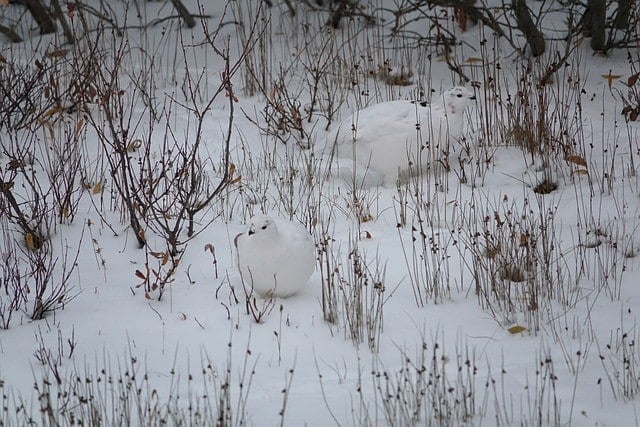
Also known as lagopus, there are three existing species of ptarmigans known today: the willow ptarmigan, white-tailed ptarmigan, and rock ptarmigans. These game birds all inhabit cold regions, so they are commonly found in alpine and arctic climates across North America, Europe, and Asia.
Except for the red grouse, a subspecies of the willow ptarmigan, all ptarmigans change their plumage to a pristine white as winter comes along. This helps them blend into the snowy background of their habitat and evade predators.
During spring, however, ptarmigans revert to their colored plumage, ranging from brown to red, grey, or black. Though they can fly, their color-changing adaptation from colored to white animals helps them conserve energy and limit the need to flee when predators attack. This energy conservation is important because food mainly consists of low-growing shrubs, which are hard to come by during the snowy months, and they have to maximize the little they can find.
Contrastingly, male members of the species take a big risk after winter because they remain white and do not molt till the mating season is over. This makes them stand out from the spring vegetation and more susceptible to predator attacks. In Native American culture, ptarmigans symbolize survival, self-preservation, and providence.
6. Taiwanese white dolphin
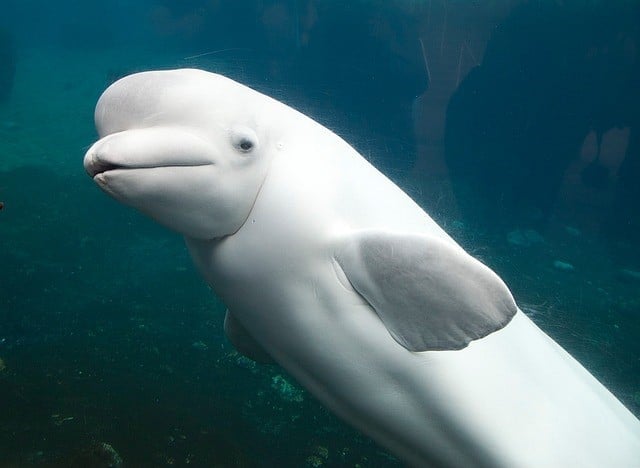
You can also call these animals the Taiwanese indo-pacific humpback dolphin. These dolphin species live almost exclusively in Taiwan’s shallow coastal waters.
Though these marine mammals may sometimes look pink due to overdeveloped blood vessels for thermoregulation, they actually have white pigment with grey spots and only look pink when they are active in regulating body temperature.
These critically endangered white animals have barely 100 individuals left in the shallow waters of Taiwan’s western coast. This reduction in their population is largely due to bycatch by trawl and gillnet fishing. Similar to many dolphins, the Taiwanese white dolphin can be friendly and endearing to humans, and its white color makes it even more uniquely interesting.
5. Arctic Hare
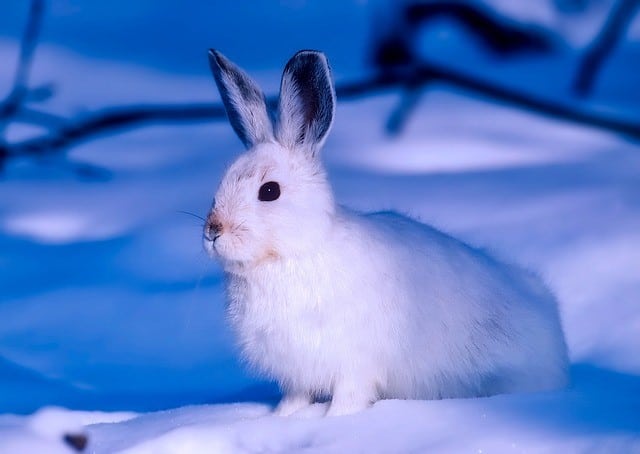
The Arctic hare is a species of hare that have evolved to survive the icy and below-freezing temperatures of the Arctic tundra. Their small bodies have a disproportionate amount of fat at 20% body fat, and this keeps them insulated through winter. Hence, they do not hibernate like many mammals inhabiting cold climates do.
Arctic hares living in the northernmost parts of the Arctic Circle maintain a white fur year-round, but those further down south may change to brown or grey during spring or summer. They are natural prey to the arctic wolf, snowy owl, and red foxes, but they are incredibly quick, especially on the snow, where they can run up to 40 mph.
Sadly, because of their affinity for immensely cold climates, arctic hares do not do well in captivity and would only live a year or two if kept as pets.
4. Snowy Egret
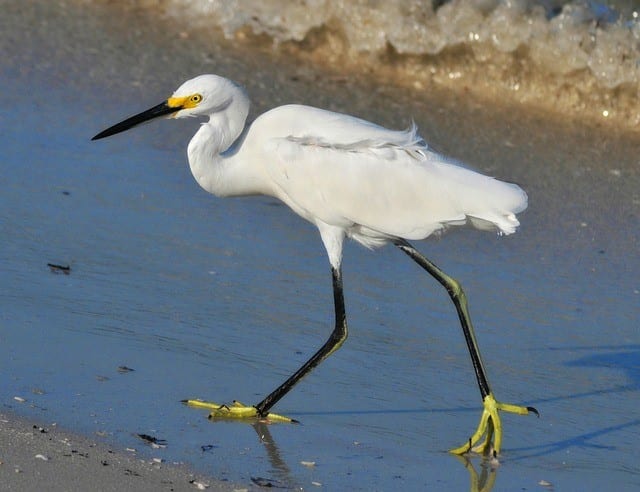
The snowy egret is a small bird of the heron family endemic to the wetlands of North, Central, and South America. It is a migratory bird that breeds in the southern USA but winters in warmer climes around Central and South America, from Mexico down south to Argentina.
They are carnivorous birds that typically feed on fish, small reptiles, crustaceans, and worms. They are also extremely social animals, forming large colonies on wetlands and pair bonds that sometimes last more than one mating season.
Though the snowy egret nestling comes out with grayish feathers upon hatching, it matures to an immaculate white plumage with only a speck of black feet and a yellow bill to highlight its white color.
3. Snow Fox
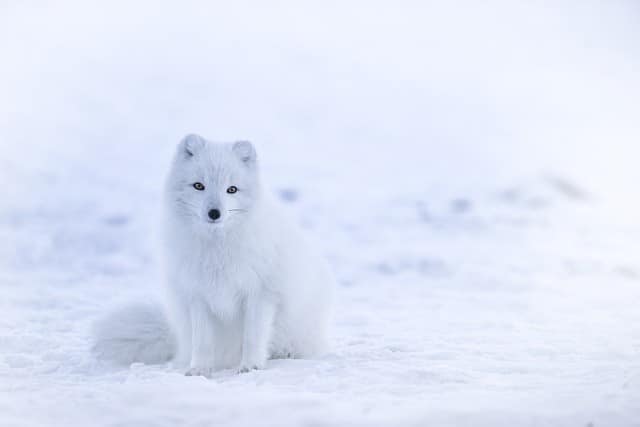
The snow fox, also known as the arctic fox or white fox, is a small fox species endemic to the northern hemisphere and the arctic tundra. They grow only up to 18 to 27 inches and feed on lemmings, fish, seabirds, and carrion when the opportunity arises.
Though carnivores, they are highly vulnerable in their habitat and often prey on by polar bears, arctic wolves, red foxes, and golden eagles. Hence, they create burrows and live in complex underground dens, only coming up for food and other necessary reasons.
These tiny cute foxes are popular for their thick white fur, which keeps them warm in their cold environment. Like other arctic animals, they revert to darker colors like brown or grey during summer.
2. Arctic Wolf
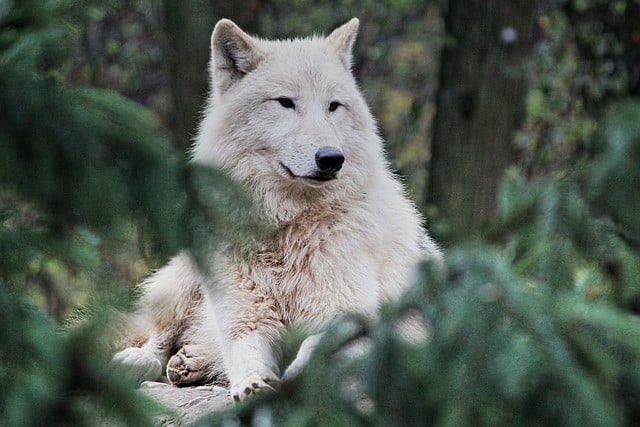
The Arctic wolf is a subspecies of the grey wolf, and it is native to the northernmost arctic tundras of Canada. They are smaller than gray wolves and generally have smaller skulls.
Though these white animals are light-grey to yellow during summer, they molt their fur to white for winter. In their favored habitat, winter can last up to nine months, so they maintain a white fur coat for most of the year.
Being canines, they require a strong social structure to thrive. Since they rarely come across people in their remote habitats, they are relatively unafraid of humans and would eagerly approach humans curiously.
Arctic wolves can interbreed and produce fertile offspring with domestic dogs. Because of this, some breeders have successfully domesticated their unique genes by crossbreeding them with domestic dog breeds like Alaskan malamutes and German shepherds, and they make loyal companion animals.
1. Polar Bears
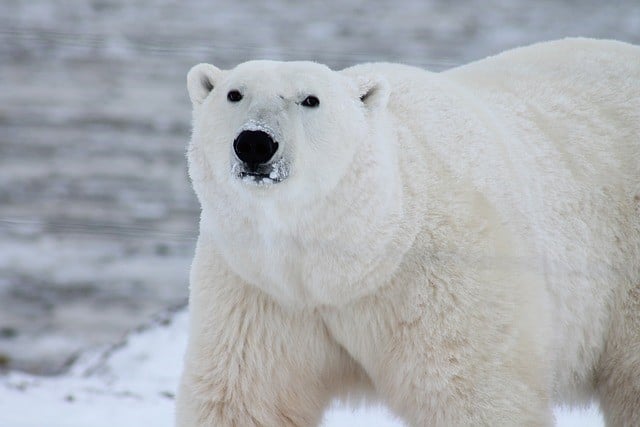
Perhaps by now, it is no surprise that many of the white animals on this list are endemic to Arctic regions. This is no coincidence. The same survival adaptation that makes vulnerable prey like ptarmigans shed their natural feathers for white ones makes apex predators like polar bears retain their white fur in their snow and ice-filled habitats.
However, unlike other Arctic creatures, polar bears do not shed their fur for a darker shade during spring and summer to blend in.
These bears are hyper-carnivorous, with much of their diet consisting of marine animals like walruses, seals, and occasionally fish, ptarmigans, and reindeer. They favor marine prey because of their high caloric demand and because marine animals are more likely to have blubber [fat] reserves than terrestrial prey.
They also maintain their pristine white fur by bathing in water or washing up with snow immediately after eating. Male polar bears can grow up to twice the size of females, and this species generally live solitary lifestyles.
Interestingly, these big burly creatures do not have a white pigment; under all that white fur is black skin. Their fur appears white because their hairs are hollow and translucent, reflecting the sun’s light.
Because of their remote and mostly uninhabited niche, Polar bears are not fond of humans and may be hostile if threatened. However, they are generally not territorial and would soon escape from an encounter rather than attack.
Unfortunately, climate change and illegal hunting for their unique fur have put these animals on the vulnerable species list by the IUCN.
Summary of top 10 white animals
You could definitely list a number of white animals even before reading this article. But we hope to have helped you learn new things about some of the cutest animals featuring a white coloration.
Hop on this article about some of the fastest animals in the world or animals that start with n.
Join our Forum for free today!

- These are The 5 Largest Great White Sharks Ever Recorded - July 19, 2024
- The Surprising Benefits of Big Game Hunting - July 18, 2024
- $100k+ Hunting Experiences The Most Expensive Animals to Pursue - July 17, 2024

